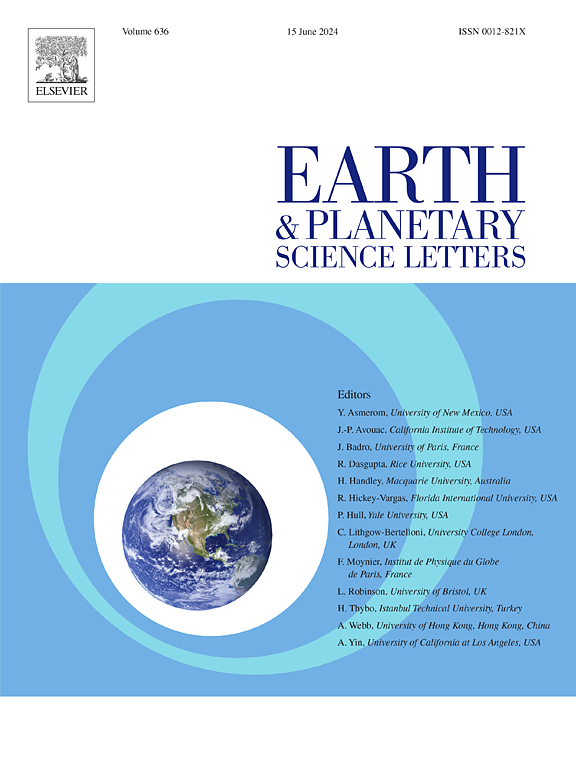Thermodynamics of Fe-S-O-C-H liquids: Implications for the Martian core
IF 4.8
1区 地球科学
Q1 GEOCHEMISTRY & GEOPHYSICS
引用次数: 0
Abstract
We present a comprehensive investigation into the composition of the Martian core. We use new density functional theory (DFT) calculations, which consider in detail the magnetic properties of the Fe alloys, essential for obtaining the correct density and velocities. We then fit our results to a new Gaussian Process Regression (GPR) equation of state (EOS). Using this GPR-EOS we search for all compositions of the Martian core in the system Fe-S-O-C-H that match both the density and compressional wave speeds of a liquid Martian core throughout its entire depth range. We consider different models for the interior of Mars – in particular, those with and without a deep melt layer at the base of the Martian mantle (Irving et al., 2023; Samuel et al., 2023; Khan et al., 2023). The existence of a deep melt layer is important as it revises previous estimates for the core's size and density. We consider a range of core-mantle boundary temperatures from 1900 K to 2850 K, although we find that temperature has a relatively small effect on the possible compositions. As with previous studies, and also for the Earth, we find many different compositions that are able to match the geophysical observations of Mars' core density (ρ) and velocity (), regardless of which set of geophysical observations are used. All models require very high concentrations of light-elements of ≈ 50 mol% in line with previous work. The compositional variation can be reduced considerably by considering cosmochemical constraints on the maximum amount of sulphur, together with geochemical constraints on the partitioning. In this case, all solutions require very high hydrogen content of at least 0.5 wt% (27 mol%) and practically no oxygen.
Fe-S-O-C-H液体的热力学:对火星核心的启示
我们提出了一个全面的调查组成的火星核心。我们使用新的密度泛函理论(DFT)计算,它详细考虑了铁合金的磁性,这对于获得正确的密度和速度至关重要。然后,我们将我们的结果拟合到一个新的高斯过程回归状态方程(EOS)。利用这种GPR-EOS,我们在Fe-S-O-C-H系统中搜索火星核心的所有成分,这些成分在整个深度范围内与液体火星核心的密度和纵波速度相匹配。我们考虑了火星内部的不同模型,特别是那些在火星地幔底部有或没有深层融化层的模型(Irving等人,2023;Samuel et al., 2023;Khan et al., 2023)。深层熔体层的存在很重要,因为它修正了以前对地核大小和密度的估计。我们考虑了从1900 K到2850 K的核幔边界温度范围,尽管我们发现温度对可能的成分的影响相对较小。与之前的研究一样,对于地球,我们发现许多不同的成分能够匹配火星核心密度(ρ)和速度(Vϕ)的地球物理观测,无论使用哪一组地球物理观测。与以前的工作一致,所有模型都需要非常高浓度的≈50 mol%的轻元素。考虑到对最大硫含量的宇宙化学约束和对分馏的地球化学约束,可以大大减少组分的变化。在这种情况下,所有的溶液都需要非常高的氢含量,至少0.5 wt% (27 mol%),几乎没有氧气。
本文章由计算机程序翻译,如有差异,请以英文原文为准。
求助全文
约1分钟内获得全文
求助全文
来源期刊

Earth and Planetary Science Letters
地学-地球化学与地球物理
CiteScore
10.30
自引率
5.70%
发文量
475
审稿时长
2.8 months
期刊介绍:
Earth and Planetary Science Letters (EPSL) is a leading journal for researchers across the entire Earth and planetary sciences community. It publishes concise, exciting, high-impact articles ("Letters") of broad interest. Its focus is on physical and chemical processes, the evolution and general properties of the Earth and planets - from their deep interiors to their atmospheres. EPSL also includes a Frontiers section, featuring invited high-profile synthesis articles by leading experts on timely topics to bring cutting-edge research to the wider community.
 求助内容:
求助内容: 应助结果提醒方式:
应助结果提醒方式:


